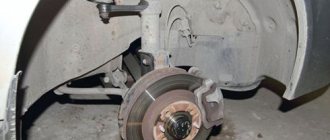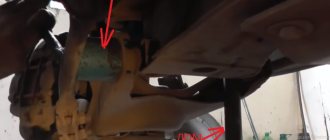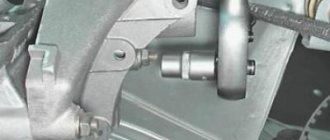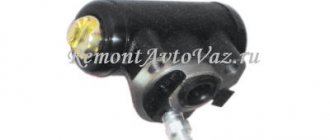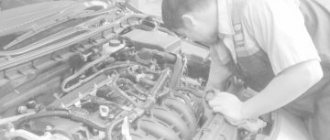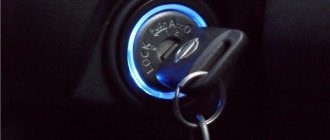Replacing rear struts
Sooner or later, every car enthusiast has to face the problem of replacing rear struts. Because driving a car with faulty shock absorbers does not bring driving pleasure. As a rule, when shock absorbers fail, an extraneous sound is constantly heard in the rear of the car, especially when the car is moving in reverse. Unfortunately, not many people decide to replace the rear struts themselves; many turn to specialized services, but we will try to understand in more detail and understand what and in what sequence needs to be done to replace the rear struts with your own hands.
Let's figure it out - what are the causes of the unpleasant noise that comes from the rear of the car.
Diagnosing a rack malfunction
- The first thing that may catch your eye is, of course, oil marks on the shock absorber. Such marks indicate that the rod seal has worn out and the shock absorber needs to be replaced, because the amount of oil inside the shock absorber is not enough for its normal operation. There are ways to restore such a shock absorber, but we will talk about this in another article.
- It is also worth paying attention to the fastening of the shock absorber itself, whether it is properly tightened, check the integrity of the bushings in the “ears” of the shock absorber itself, there may be wear on the bolts themselves.
- It is worth paying attention to the spring, if it has burst somewhere, it is worth replacing it and always on both sides, such things should only be changed in pairs.
You can carry out such diagnostics without removing the shock absorber from the car, but to check the shock absorbers in more detail, the shock absorber must be removed.
Let's take a closer look at the process of removing the rear shock absorbers.
So, having carried out the initial diagnostics, we did not identify any problems with the shock absorbers, but we also did not solve the problem with unpleasant noises and knocks, so let’s remove the shock absorber.
Removing the shock absorber
For this we need:
- An overpass or an ordinary inspection hole in your garage or a friend’s, without access to the shock absorber mounts from below the car, it will be almost impossible to remove it, at least I didn’t succeed J
- A standard set of tools, it is desirable that in addition to open-end and ring wrenches there would also be a wrench or ratchet with heads.
- Of course, a lifting mechanism is needed - in our case, a jack is suitable for this.
We remove all decorative panels and protection in the trunk of the car to provide access to the upper shock absorber mount.
Once access is secured, unscrew the three nuts that secure the shock absorber support cup to the car body.
For better access, it is better to remove the wheel, naturally jacking up the car.
Now unscrew the lower bolt(s) that secures the shock absorber to the car beam.
Pull the shock absorber and spring out.
Now we need to remove the spring so that we can check and inspect our shock absorber in more detail. To do this we will need spring ties like those in the photo
We compress the spring with zip ties to release the shock absorber support cup from the load. Now, using a 19 mm wrench and a hexagon, unscrew the nut (seen in the photo)
Checking the shock absorber.
After we have removed the shock absorber, we can check it on a flat surface. To do this, we need a bolt that can be inserted into the holes of the lower shock absorber and arm mounting. We try to compress and unclench the shock absorber, if shocks are felt when compressing or the shock absorber simply falls down without effort - such a shock absorber is not suitable. Also, when stretching the shock absorber, it should “go” smoothly with a relatively small force; if it rises up easily, such a shock absorber is faulty. It is also worth paying attention to the shock absorber rod, if it has obvious signs of wear, holes, rust, or is completely bent - such a shock absorber should also not be installed on a car. If, when you try to compress or expand the shock absorber, it does not work, it is simply jammed, but a jammed shock absorber would be noticeable when it was installed on the car. The car would not succumb to rocking despite attempts to rock it.
In this video you can see which struts are unsuitable, and also understand what force is needed to check the shock absorber
Having discovered a faulty shock absorber, we ask ourselves what kind of shock absorber to buy now so that it will last a long time.
How to choose a shock absorber
At the moment, there are a very large number of shock absorber manufacturers on the market and it is very difficult to give preference to any brand, let’s just look at which shock absorbers are better and which are worse, gas-oil or oil.
I would like to note right away that gas-oil shock absorbers are thirty percent more expensive than oil shock absorbers, unlike oil shock absorbers, which use only oil; gas shock absorbers are also pumped with gas under pressure. Gas-oil shock absorbers hold the road better, i.e. provide your car with better downforce of the wheels to the road, while your car behaves more confidently on the road, this is especially noticeable when taking sharp turns or sharp maneuvers on the road. If you prefer to feel confident behind the wheel of your car and love a comfortable ride, then the choice is obvious; you need gas-oil shock absorbers.
In general, the characteristics of oil shock absorbers are not very different from gas shock absorbers and may well be suitable for motorists who have a relaxed driving style and are not so picky about ride quality. If you use your car to get from home to work and go to the country on weekends, oil shock absorbers are quite suitable for you, and you will save at least thirty percent on the cost of shock absorbers compared to gas ones.
Once you have decided which shock absorbers you need and have purchased, do not forget to bleed the shock absorbers before installation as shown in the video below
After the shock absorber is assembled, we install it in the reverse order as described above.
Modernization of shock absorbers
Not every owner likes the soft suspension of the 7. To make the car more assembled, reduce roll and sway, and increase rigidity, car enthusiasts resort to modifications, replacing original shock absorbers with products with other characteristics. For example, to stiffen the rear suspension without any modifications or alterations, you can install shock absorbers from Niva. Based on the reviews of many owners of the “Seven”, after such changes the car becomes a little stiffer and holds the road better.
Double
To install dual shock absorbers you will need:
- 4 rear shock absorbers;
- set of heads, screwdrivers, keys;
- hammer;
- welding machine.
The essence of the modification comes down to the fact that it is necessary to manufacture and attach to the body a bracket for the second damper.
To install the second shock absorber, you will need to make and secure a bracket
Installation of the latter to the rear axle is carried out together with a standard shock-absorbing element using a long bolt or stud. The procedure is carried out the same way on both sides.
The second shock absorber is secured from below with a long bolt or pin
With such modifications, it is recommended to install new shock absorbers.
Sports
If the car is modified for a sporty driving style, then the changes apply not only to the rear, but also to the front suspension. For such purposes, it is convenient to use a suspension kit, which includes springs and shock absorbers. Depending on the goals pursued, the installation of such elements is possible both without changing the ground clearance and with lowering the suspension, ensuring maximum rigidity in all modes of damper operation. The kit allows you to get excellent car handling. However, you can install sports elements separately - in front or behind, which depends only on your wishes. One of the common options for sports shock absorbers installed by owners of “sevens” and other “classics” is PLAZA SPORT. Installation is carried out in place of standard parts without any modifications.
Among sports shock absorbers, VAZ 2107 owners often install PLAZA SPORT
The seventh model Zhiguli is technically a fairly simple car. However, poor quality road surfaces often lead to failure of suspension shock absorbers. It is not difficult to identify malfunctions of these elements even in a garage, as well as to replace them. To do this, it is enough to prepare the necessary set of tools, read the step-by-step instructions and follow them during the work process.
Pashok21074 › Blog › replacement and maintenance of rear shock absorbers)
replacing rear shock absorbers on a VAZ 2107
We replace the rear shock absorber on a VAZ 2107 when fluid leaks from it or when it loses the ability to dampen vibrations (swaying of the VAZ 2107 when driving). The rear shock absorbers on the VAZ 2107 should be replaced on both sides, even if one of them is working.
Removing the rear shock absorber from a VAZ 2107 car
1. We install the VAZ 2107 car on an inspection hole or overpass. When removing the rear shock absorber from a VAZ 2107 car on a horizontal platform, which is less convenient, remove the wheel and use a jack to lift the rear axle from the side of the shock absorber being replaced.
2. Using a 19 mm wrench, unscrew the nut of the bolt securing the rear shock absorber to the rear axle bracket, holding the bolt from turning with a wrench of the same size.
What kind of rear struts are installed on the Chevrolet Lacetti from the factory?
The rear pillars for the station wagon are 3 mm longer.
Each of them copes with its task differently - converting kinetic energy into thermal energy, thereby damping vibrations and smoothing them out. According to General Motors engineers and their Korean colleagues, the best option for the Lacetti in sedan, hatchback and station wagon bodies would be gas-oil shock absorbers. They are installed at the factory.
Articles
The left post is preparing to take its place.
The catalog numbers of the rear shock absorbers for the hatchback and sedan are the same:
- Rear left: GM-96407821.
- Rear right: GM-96407822.
Differences in bodies
On a station wagon you will have to disassemble the trim.
The racks for the station wagon received the number GM-96408640 and their difference is that their rod diameter is 22 mm, while those of the sedan and hatch are 20 mm. Visually, they differ in the thickness of the glass - 49 versus 45 mm. Of course, this is not the only difference.
However, third-party manufacturers do not favor rear struts for the Lacetti SW and produce them much less frequently than for the hatch and sedan.
Symptoms of a problem
The car body must maintain a horizontal position when driving. This condition will only be met if the shock absorbers are in good working order. If the body is supported only by elastic elements, springs or springs, its vibrations will not be damped, and this is not only a lack of comfort, but also the creation of an emergency situation on the road. Shock absorbers are constantly working while the car is moving, so the parts of this device wear out.
Therefore, periodic repair of struts or replacement of rear shock absorbers is necessary. Many vehicle owners pay attention to the condition of the struts or rear shock-absorbing devices when their functionality completely fails. For such owners, it would be useful to learn about what can lead to failure of these components, what signs of malfunction of these devices may be, and how to change the shock absorber. Let's look at some signs of wear and tear on these components:
- The vehicle bounces while driving on uneven surfaces;
- After overcoming the unevenness, the vibrations do not stop, but continue for some time;
- Traces of hydraulic fluid leaks appeared on the body;
- Damage to the shock absorber strut housing was discovered;
- The operation of the shock-absorbing device is accompanied by a grinding or knocking sound;
- There was a noticeable deterioration in the car's handling when driving on uneven roads;
- Strong shaking when driving over potholes.
Not only poor road conditions, but also sagging springs, torsion bars, and rubber cushions accelerate the failure of shock absorbers. If you detect even the slightest signs of poor performance of the shock absorber struts of your car, you can check their performance yourself. To do this, you do not need to purchase expensive equipment and tools. It is enough to press firmly on the front or rear of the car until it stops, and then release the body.
The most common faults
Among the most popular malfunctions are:
- Fluid leaks;
- Deformations and mechanical damage to the housing;
- Damage to the rod or piston;
- The oil is inappropriate or of poor quality.
Leaks can occur due to wear of oil seals or other seals. Oil seals also wear out naturally - the rod is constantly moving, so the edge of the oil seal wears out after some time. However, most often the oil seal gets damaged due to corrosion, scuffing and dust, sand on the rod.
Deformation of the housing is usually caused by impacts on the housing of the damping device. Dents do not allow the rod to move normally to its full height and in the place where there is deformation, the piston can rest.
The piston can be damaged only in one case - if the car falls into a hole at speed. The damper cannot withstand it and breaks through. At the moment of breakdown, the piston collides with the bottom of the chamber, which causes damage to the piston. As a result, the valves are also damaged, and the processes of oil flow from chamber to chamber are seriously disrupted.
Oil is the working fluid in a car shock absorber. The operation of the damper depends entirely on its characteristics and quality. If the oil has a low viscosity, then there will not be the required resistance to the movement of the piston - the damper will “break through” even on small bumps. In winter, oil with a higher viscosity will create too much resistance.
How to properly check shock absorbers on and off the road
You can determine whether the damper is working properly by its appearance. If traces of oil are visible on the body, this indicates a violation of the tightness of the chambers due to wear of the oil seals or seals. The properties of such a damper will be below normal or will not exist at all.
The body is also inspected for deformations - even a slight dent can lead to difficulty moving the piston and to complete jamming.
Fasteners must be intact and not damaged by corrosion. The rubber bushings installed in the lower hinge must also be intact and have no signs of destruction.
The damper rod must have a perfect mirror surface. If there is no mirror, then the piston has no movement and the shock absorber does not perform its function.
If the shock absorber has already been removed, then to check it, install it vertically. The bottom bracket is fixed with your feet, and the rod is pulled out with your hands and released. If the shock absorber is working properly, then the resistance to the upward movement of the rod should be much greater than the resistance when the rod moves down.
If the rod moves both down and up with the same force, then there is little or no oil in the cylinders. If the resistance decreases in the extreme positions of the rod, then this indicates air in the chamber cylinder.
You can check the operation of the shock absorbers on the car. To do this, swing the car by the front and then by the back. If the damper is working properly, the car will swing once. If the rack is jammed, you won't be able to rock the car.
What other problems are possible?
Front shock absorbers or rear shock absorbers are connected to the body and suspension through rubber pads or silent blocks. These are the parts that get damaged first. Their service life depends on the quality of the materials used in manufacturing, the operating conditions of the machine, and some other factors. Long-term operation of a car with a faulty shock absorber not only impairs travel comfort, but can lead to breakage of the bolts securing this unit to the car body or suspension parts. It is impossible to move a car with such damage, except to get to the garage or repair area. Not everyone will be able to fix such a malfunction on their own, since you will need a welding unit, cutting machine, and other tools. It is best to prevent such problems, monitor the condition of the shock absorbers, change or repair them in a timely manner.
How to extend the life of car struts
To extend the service life of the racks, it is recommended to regularly treat the underbody of the car with anti-corrosion compounds. In the cold season, immediately after starting the car, you should not perform any sudden maneuvers or actions.
Sudden acceleration and braking with cold oil in the rack will significantly reduce the service life of parts. Well, one more tip - overcome serious obstacles at low speed.
Source
Shock absorber repair or replacement
Experienced motorists can share their experience in repairing such components. Domestic cars and some foreign cars had shock absorbers that were subject to repair. In retail chains there were repair kits consisting of a piston ring and rubber seals. It was also possible to purchase hydraulic fluid for shock absorbers. The upper part of the body was closed with a threaded lid.
They unscrewed it, drained the liquid and pulled the rod and piston out of the body. The worn piston ring is replaced with a new one, fresh fluid is poured in and the assembly is assembled. Next, the restored unit should be pumped and installed in place. Subsequently, the racks began to be made non-removable, which after failure were replaced with new products.
About replacing shock absorbers
If the diagnosis of a malfunction of this device does not raise doubts among the vehicle owner, the shock absorber must be replaced. This operation is not particularly difficult; even novice drivers can perform it. You also don’t need any special tools; all you need is a car jack and a set of wrenches. Particular attention should be paid to the choice of a new front strut or rear shock absorber. On sale you can find spare parts from dubious manufacturers, which can quickly become unusable.
Before you get started, you should consider the equipment needed to repair and replace shock absorbers. A repairman may need the following tools and accessories:
- Car jack;
- Wheel removal key;
- Reliable stand under the car body;
- Set of wrenches;
- Torque wrench;
- Liquid WD-40 or similar;
- Crowbar or small crowbar;
- Metal brush to remove dirt;
- Wheel lock to prevent vehicle movement.
In some conditions, you may need a wrench extension to unscrew a “stuck” fastener, and this happens quite often. Work should begin only when stops are installed under the wheels to prevent the machine from rolling away. There is no fundamental difference in removing and installing the front or rear shock absorber, so we will focus on one of them.
What kind of rear struts are installed on the Chevrolet Lacetti from the factory?
The rear pillars for the station wagon are 3 mm longer.
Each of them copes with its task differently - converting kinetic energy into thermal energy, thereby damping vibrations and smoothing them out. According to General Motors engineers and their Korean colleagues, the best option for the Lacetti in sedan, hatchback and station wagon bodies would be gas-oil shock absorbers. They are installed at the factory.
Articles
The left post is preparing to take its place.
The catalog numbers of the rear shock absorbers for the hatchback and sedan are the same:
- Rear left: GM-96407821.
- Rear right: GM-96407822.
Differences in bodies
On a station wagon you will have to disassemble the trim.
The racks for the station wagon received the number GM-96408640 and their difference is that their rod diameter is 22 mm, while those of the sedan and hatch are 20 mm. Visually, they differ in the thickness of the glass - 49 versus 45 mm. Of course, this is not the only difference.
However, third-party manufacturers do not favor rear struts for the Lacetti SW and produce them much less frequently than for the hatch and sedan.
Removing the shock absorber
Replacing the shock absorber struts yourself can be done in the garage. An inspection hole or a lift can make the work easier, but you can do without it. Let's look at how to change the rear shock absorber in more detail. Car suspensions have some features, which include the placement of the spring and the shock-absorbing device itself. It can be inside the spring or outside it. If it is inside a spring, you will need zip ties to compress it. A few hours before starting work, the fasteners should be treated with WD-40. The further algorithm for removing the shock absorber will be something like this:
- The gearshift knob is set to the first gear position. Stops are placed under the wheels, the body is lifted and placed on stands.
- Next you need to remove the wheel.
- Wires coming from the ABS sensor and brake hoses may interfere with dismantling the faulty part. The connector with the wires is disconnected, after which they are taken to the side. The brake hoses are removed from the clamps and also removed from the work area.
- When replacing front shock absorbers, you may need a steering linkage puller. Before lifting the body, you need to loosen the top nut securing the strut to the car body.
- After all the preparatory work has been completed, you can begin to unscrew the fasteners of the strut or shock absorber to the suspension.
- If you cannot immediately unscrew the nut of the fastening bolt, try using an “extension”, which can be a pipe of a suitable size. Local heating of the nut with a hair dryer helps. Using a worn tool can damage the edges of the nut, so check the condition of the wrenches before working.
- When the nuts are unscrewed, the bolts are removed from the eyes and the faulty shock absorber is removed for inspection and detection of defects.
Advice! Two shock absorbers on one axle should be replaced at once, otherwise the suspension geometry will be disrupted, and this will disrupt the stability and controllability of the vehicle while driving.
Why do you need shock absorbers in a car, how they work
Front and rear shock absorbers are damping elements in a car's suspension. Paired with an elastic suspension part, which is a spring or torsion bar, the shock absorber performs several main functions:
- Damping vibrations of wheels and body;
- Maintaining wheel traction with asphalt;
- Ensuring a smooth ride.
To understand how a shock absorber works, you need to understand how it interacts with other suspension components. So, shock absorbers are necessary to reduce the amplitude of body vibrations, which appears as a result of the operation of elastic elements.
The elastic element is a spring, which is attached to the shock absorber. This design is called a rack.
The operating principle is based on hydraulic or gas resistance. Oil is most often used as the working fluid.
The shock absorber consists of two elements – a piston and a cylinder. The cylinder contains chambers filled with gas, oil, or oil and air. The piston moves inside the cylinder - it can rise or fall.
In the case of oil, the piston experiences resistance when moving, created by the flow of oil through special valves into another chamber. If the damper is gas, then the piston resists the pressure exerted by the compressing gas - gases are poorly compressed and also poorly decompressed.
Due to this resistance, the piston can move smoothly and steadily, which leads to a shock dampening effect.
What is the difference between a strut and a shock absorber?
If we highlight the main differences between struts and shock absorbers in a list, it will look like this:
- A shock absorber can perform the functions of an element of a strut and not vice versa, since the strut functions as a shock absorber with a support spring and a steering rod;
- The stand has a reinforced body and rod;
- The stand has a higher price;
- While the strut is subject to lateral loads, the shock absorber only dampens vibrations;
- If you compare a strut with a simple shock absorber, then the strut gives the car reliability;
- A faulty shock absorber will cause some inconvenience to the driver, and a faulty strut will mean an uncontrollable car.
Installation of a new product
Install a new unit or after repairing it in the reverse order. Before this, carefully clean its body from dirt or other foreign objects with a metal brush. It is advisable to coat the cleaned body with protective paint to prevent the possible occurrence of corrosion. The installation eyes of the front struts are treated in the same way. Next, check the fastening elements, carefully inspect the threaded part of the bolt and nut; it should be full-size, without visible damage. If something is found, it is better to replace the fasteners with new parts. First of all, combine and secure the upper attachment point. Next, lift the suspension with a jack, align the lower point and install the fasteners in the eyes. The nuts are tightened with a wrench, and the tightening torque is checked with a torque wrench.
